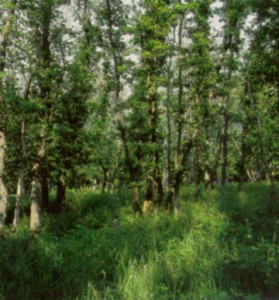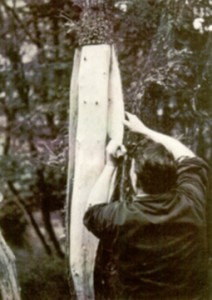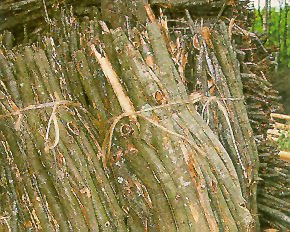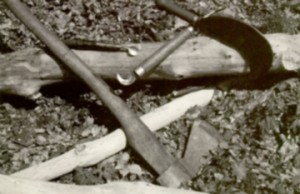Oak bark as an element of the landscape

Oak shrubs are characteristic because of their young age and their multiple stem stocks. Today only a few of these shrubs are used in forestry. Special interventions and care are necessary to let those shrubs mutate to high stem trees.
Up from the middle of the 18th century until nowadays Luxembourg was covered by large parts of oak shrubs used for leather tanning. Most of these low oak woods are to be found in the northern part of Luxembourg, called Eisléck, but in Ernster there is also one of these woods called “Warschent”, witness of the ancient woodland management.

Paring with the help of the “coppicing knife”
On the contrary of a normal wood where mainly high single trunk trees are growing, these low height oak shrubs show the typical woody plant multiple stems and its management represents a special forestry strategy, between agriculture and siviculture. In their first years, those woods had been used mainly for their fruits (for example buckwheat).

The barks were transported to the tannery, packed in 25 kg bundles
In order to preserve animal skins and for the leather production, oak barks, rich in tannin, were peeled off from 15 to 30 years old low oak shrubs , whose multiple stems continued to grow in order to be cut down and peeled again 15 years later.

To pare and to slit the bark they used the “Lohschleißer”, the spoon, the tip and the ax
The oak shrubs in Ernster are representing naturally grown vegetation, as the ones in the Eisléck are mainly cultivated. Even if the shrub forestry had already been used for the firewood supply during the Middle Ages, its hey-day came only later on with the leather production. In Ernster this form of forestry had only been run by the farmers as a kind of supplementary sideline (“Warschent” only 20 to 25 ha). The regression of the coppicing in Luxembourg started with the developing influence of imported tanning agents and later on with the synthetic tanning substances replacing the natural bark extracts.
“An de Waelen”

A Neolithic hatchet and an arrowhead
At the north-east border of the Grünewald there is a small clearing called “An de Waelen”. During the last few millenniums hunters and fishermen always again visited this location, as it probably had ever been a kind of seasonal lair, or maybe also a workshop place, as some arrowheads and blade fragments have been found there. The discoveries are proved to belong to 3 different Stone Age periods: Palaeolithic, Mesolithic and Neolithic. Reasons for the “popularity” of this place could have been its hollow like position, protected by winds and rains, as well as the presence of a spring and a small river, attracting all kinds of game.
